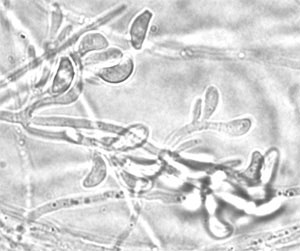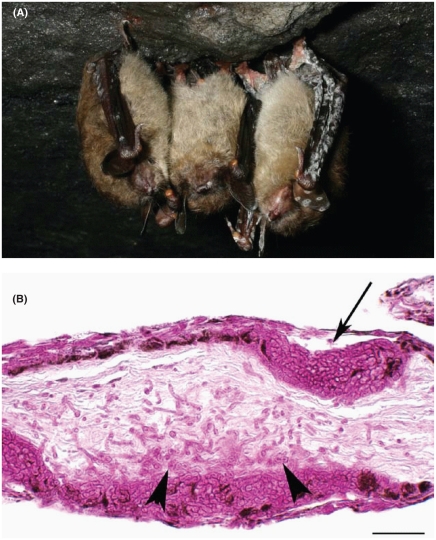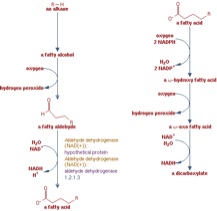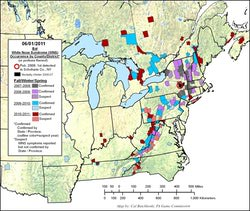Geomyces Destructans
A Microbial Biorealm page on the genus Geomyces Destructans

Classification
Kingdon: Fungi
Subkingdom: Dikarya
Phylum: Ascomycota
Subphylum: Pezizomycotina
Class: Leotiomycetes
Order: Helotiales
Family: Myxotrichaceae
Genus: Geomyces
Species: Geomyces destructans
White Nose Syndrome in Bats Microbe Wicki Page: http://microbewiki.kenyon.edu/index.php/White_nose_syndrome_in_bats
Description and Significance

Geomyces destructans is a fungus thought to be responsible for the large number of bat deaths in New England over the last several years. It first presented itself in the US in 2006 and then in Europe specifically France, in 2009. Until recently G. destructans was thought to be a normal resident inhabiting bats around the world. Further research links this to “white nose syndrome,” and even more recent research shows a 100% match between the DNA of Geomyces destructans and the fungus found on the dead bats [1]. (Chaturvedi et al) Further study is needed on this subject; reachers do not seem to be sure if the fungus is stemming from pest control measures or how and why this has recently devastated bats around the world.
Since first observation near Albany, NY in 2006, white nose syndrome has decimated populations of cave-hibernating bats in the northeastern United States, with mortality rates of 75-95%. In 2009, the infection area extended from northeastern New Hampshire to southwestern Virginia and expanded into Tennessee and Canada in 2010 [2]. Outside of North America, Geomyces destructans has also been observed in colonized bats across Europe. It is not yet obvious how the infection is influencing the bat populations in Europe [10].
.
Genome Structure
A total of 9075 genes coding for proteins have been sequenced for Geomyces destructans in a genome of 29,706,106 base pairs to code for them. Liner mitochondrial DNA has also been sequenced but little information is available on genetic specifics at this time. (NCBI)http://www.ncbi.nlm.nih.gov/pubmed/.
Metabolism

Fatty acid ω-oxidation in Geomyces destructans was researched by metacycy. http://metacyc.org/. Geomyces destructans, along with other industrial yeasts, are capable of using fatty acids and alkanes as carbon sources. The methyl group at the end of the molecule is initially oxidized to a hydroxyl group, then to an oxo group, and terminally to a carboxyl group. The long chain of dicarboxylates derived from ω-oxidation then go into the β-oxidation pathway for further breakdown [6]. In the environment, polyunsaturated fatty acids, specifically linoleic and a-linolenic acid, are important for hibernating animals. Bats severely affected by White Nose Syndrome have been shown to exhibit higher amounts of α-linolenic acid in their white adipose tissue [7]. Contrariwise, bat species’ not heavily afflicted by white nose syndrome have higher amounts of linoleic acid in their white adipose tissue. In order for Geomyces destructans to survive it must utilize the α-linolnic acid as a carbon source. Dietary fatty acids can be excreted through sebaceous glands on the bat, which the fungus comes into contact with. Geomyces destructans is unable to metabolize linoleic acid as a carbon source but may metabolize a-linolenic acid. If bats differ in their relative ratios of fatty acids this may play an important role in species, diet, and range specificity to white nose syndrome and hence bat survival [7].
Ecology

White nose syndrome in bats was initially observed in 2006 at a single cave near Albany, New York. WNS has since been found in 14 states and 2 Canadian provinces, spreading up to 800 miles in 2009 [2]. This is of particular concern to scientists due to many bat species’ important role in their ecosystems. Not only does the decreasing umber of bats affect the environment but it also impacts humans. Bats are responcible for consuming large amounts of insects. A single Little Brown bat can consume one thousand insects in a night [2]. In the US, farmers spend significant amounts of money attempting to control pests, and with the decline of the bat population, farmers will be forced to take more drastic measures to regulate their crops and herds. This also increases the risk to humans from insect borne disease. Bats also feed the members of the microenvironments in caves. The loss of the bats to a cave, would destroy it’s ecosystem. Geomyces destructans is also known to speed between heavily visit caves without the help of bats. Spores of Geomyces destructans have been transferred from cave to cave through human contact as well as animal. [2]Other related species are commonly found in the soil and air and do not usually elicit an immune response in humans.
Pathology
Geomyces destructans is a psychrophilic dermatophyte. This type of fungus can grown in cold conditions and cause infection of the skin due to it’s keratin obtaining ability. This fungus can attack the skin of muzzles, ears or wing membranes, and fills hair follicles, sebaceous glands and sweat glands. Geomyces destructans negatively influences water balance in the bat, thus disrupting energy consumption. Infection with the fungus may also disrupt blood circulation and gas exchange through the skin [8]. Hyphae and white conidia powder have been found on bats, but the fungus elicits no immune response or inflammation when infected [3]. While the bats are hibernating, the fungus infects the designated areas and begins to replace and digest the living skin or tissues. Studies show that while bats are hibernating, their metabolism slows to a crawl, their body temperature decrease, and their immune system is depressed [9]. These conditions leave the bats susceptible to Geomyces destructans which grows optimally at 1-15C.
References
[1] Chaturvedi V, Springer DJ, Behr MJ, Ramani R, Li X, et al. (2010) Morphological and Molecular Characterizations of Psychrophilic Fungus Geomyces destructans from New York Bats with White Nose Syndrome (WNS). PLoS ONE 5(5): e10783. doi:10.1371/journal.pone.0010783
[2] G. G. Turner, D. M. Reeder, and J. T. H. Coleman. 2011. A Five-year Assessment of Mortality and Geographic Spread of White-Nose Syndrome in North American Bats, with a Look at the Future. Update of White-Nose Syndrome in bats. Bat Research News, 52:13-27.pdf
[3] Gargas, A., M.T. Trest, M. Christensen, T.J. Volk, and D.S. Blehert. "Geomyces Destructans sp. nov. associated with bat white-nose syndrome." Mycotaxon 108.1 (2009): 147-54. Print.
[4] KUBÁTOVÁ1, ALENA, ONDŘEJ KOUKOL, ALENA NOVÁKOVÁ, and CZECH MYCOL. "Geomyces Destructans, Phenotypic Features of Some Czech Isolates." CZECH MYCOL 63(1): (2011): 65-75. Print.
[5] Courtin, F., WB Stone, G. Risatti, and K. Gilbert. "Pathologic Findings and Liver Elements in Hibernating Bats With White-Nose Syndrome." Veterinary Pathology. Veterinary Patholog, doi: 10.1177/0300985809358614 Mar. 2010. accessed Web. 03 May 2012. <http://vet.sagepub.com/content/47/2/214.full>.
[6] Caspi et al., 2012, "The MetaCyc Database of metabolic pathways and enzymes and the BioCyc collection of pathway/genome databases", Nucleic Acids Research in publications resulting from its use. http://metacyc.org/ http://www.ncbi.nlm.nih.gov/
[7] Amy Whistle1, Evan Pannkuk2,3, David Gilmore1, Ellis Benjamin3, Earl Benjamin3, FATTY ACID METABOLISM BY GEOMYCES DESTRUCTANS. Department of Biological Sciences, Graduate Program in Environmental Science, Department of Chemistry and Physical Sciences Arkansas State University, State University https://ncur.weber.edu/ncur/archive/Display_NCUR.aspx?id=52845
[8]Wing pathology of white-nose syndrome in bats suggests life-threatening disruption of physiology. Paul M Cryan1, Carol U Meteyer2*, Justin G Boyles3 and David S Blehert.November 2010
[9]Serological, hematological and immunological research on hibernating bats. Jaeger R Experientia 1963, 19:596-598.
[10] Wibbelt G, Kurth A, Hellmann D, Weishaar M, Barlow A, Veith M, Pruger J, Gorfol T, Grosche L, Bontadina F, et al: White-nose syndrome fungus (Geomyces destructans) in bats, Europe. Emerg Infect Dis 2010, 16:1237-1243.
